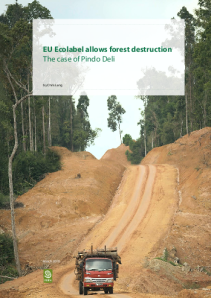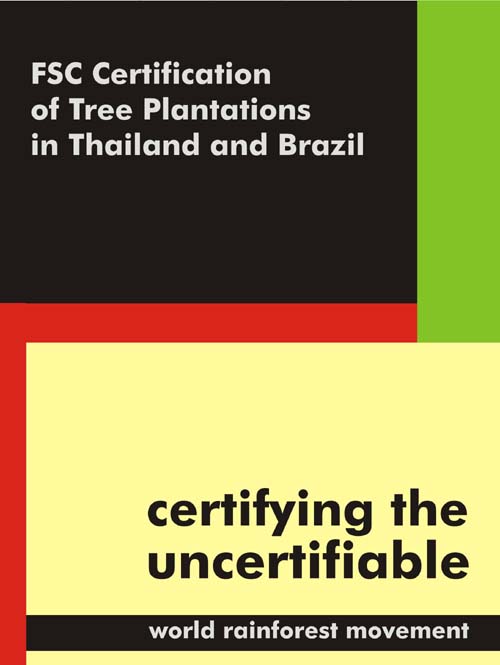Assisted by the ADB, Japanese and Indian pulp corporations are taking over thousands of hectares of villagers’ forests, commons and farmlands in Laos.
By Chris Lang. Published in WRM Bulletin 104, March 2006.
For over a decade a network of interests has been pushing industrial tree plantations in Laos. The key organisation is the Asian Development Bank. In 1993, the Lao government approved a Tropical Forest Action Plan (TFAP), carried out with funding from the ADB and the World Bank, among others. The TFAP recommended logging the forests and establishing industrial tree plantations on degraded forest land.
Shortly afterwards, the ADB started its Industrial Tree Plantation Project which ran until 2003. The ADB rated this project as “unsuccessful”. A Bank evaluation of the project stated that “people were driven further into poverty” as a result of the project (see WRM Bulletin 103). Unperturbed, the ADB started a new Forest Plantations Development project in January 2006. With this new project, the process of replacing villagers’ commons, fields and forest land with monocultures is accelerating. The ADB’s six-year project aims “to promote a sufficiently large area of industrial plantations to attract a pulpmill and/or one or more MDF plants to Lao PDR in the not too distant future.”
In February 2005, a couple of months after an ADB-supported Private Sector Consultation Workshop in Vientiane, Oji Paper bought up BGA Lao Plantation Forestry’s 154,000 hectare concession in Laos, one-third of which it plans to plant with industrial tree plantations. Oji Paper is one of Japan’s largest pulp and paper companies and is the sixth largest paper and board producer in the world by volume. The company has a total of 140,000 hectares of overseas plantations operations in China, Vietnam, Australia, New Zealand and Brazil.
In March 2006, the Indian Aditya Birla Group announced that it will invest US$350 million in industrial tree plantations and a 200,000 tons-a-year dissolving pulp mill in Laos. The Lao government has leased 50,000 hectares to the Group for 75 years. Three companies, all owned by the Aditya Birla Group, will invest in the project: Grasim Industries (India) which will own 51 per cent; Thai Rayon (Thailand); and PT Indo Bharat Rayon (Indonesia).
The pulp mill is planned to be built seven years after the first eucalyptus trees are planted. The pulp will be exported to Aditya Birla’s rayon fibre manufacturing operations in Thailand, India, and Indonesia.
The Aditya Birla Group has annual sales of US$7.6 billion. The Group describes itself as “India’s first truly multinational corporation”. The Group has seven pulp and fibre plants, in India, Thailand, Indonesia and Canada, with a total capacity of 775,000 tons a year. It is the world’s largest producer of viscose stable fibre. The Group’s chairman, Kumar Birla, is one of the richest people in the world, with a net worth of US$4.4 billion, according to Forbes magazine.
In recent months I have received several eyewitness reports about the impacts of industrial tree plantations in Laos. The following are edited extracts from these reports which, I’m afraid, will have to remain anonymous.
“It is now patently obvious driving along Route 13”, writes one observer, “that what was healthy lowland forest just five to ten years ago is now being converted into eucalyptus plantations, including former flooded forest in the Nam Hinboun and Nam Pakan floodplains.”
Oji Paper is clearing large areas of forest in areas close to the ADB-funded Theun Hinboun dam, between Route 13 and the Hinboun River. “It is a real disaster there,” an anonymous critic tells me. “Many people, who have already suffered from catching less fish in the Hinboun River from the dam problem, are now getting the double problem with plantations. The company is getting all kind of forest now. The [Lao government’s] Land and Forest Allocation process has completely failed in this aspect, because the process cannot keep or give forest to people, but is helping companies to clear forest and help them to grab all the land from the people. People simply have no space to breathe right now. ADB is really shameless to claim that they are helping the poor and the forest.”
The ADB and the Lao government claim that the plantations are only being planted on degraded forest. But, “degraded forest is often another word for healthy, recovering forest with wide utility value to villagers and biodiverse in flora and fauna,” as another writer points out.
The problem that the ADB seems unable or unwilling to grasp is that villagers are dependent for their livelihoods on their forest and common land. One observer describes how villagers collect “resin, firewood, mushrooms, insects and frogs in the wet season and grasses for roofs,” from “fairly heavily disturbed dry dipterocarp forests”. Villagers also use the land to graze cattle.
“People conclude that the plantations are not for their benefit, but are for the benefit of business,” writes another critic. “Villagers have lost their land. Eucalyptus plantations are supposed to be reforestation and are supposed to be planted in degraded forests. But villagers say that eucalyptus plantations are very different to forest.”










One Response to “Laos: Indian and Japanese pulp giants move in”